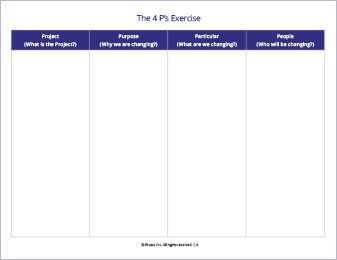Connecting Change to Business Results With the 4 P's Exercise

3 Mins
Updated: March 2, 2024
Published: June 15, 2022

How do you introduce change management to the stakeholders of a project you're supporting? Leveraging the 4P's—project, purpose, particulars and people—is a great way to help any audience see the connection between change management and achieving results.
The 4 P's Exercise is an activity you can complete anytime, anywhere to jumpstart a discussion on change management. All you need is a sheet of paper and an organizational project or initiative your audience cares about.
Use Prosci's handy template as a starting point for your 4 P's Exercise.
Connect Change Management to Project Success
Instead of beginning the conversation by describing what change management is, the 4P's framework enables you to start with a simple analysis about the nature of change and your specific project to demonstrate why change management is critical to success.
The goal is to demonstrate connections between the project, intended outcomes, and employee groups who will be impacted by the change effort while slowly and purposefully identifying four key elements of the change.
The most important thing you can do is enable your audience to make this connection themselves. Although it sounds like common sense, the impact can be significant. Walking project leaders, project teams, senior managers and change sponsors through the process below helps create the "aha!" moment that cannot be achieved by simply explaining the importance of change management.
Steps to Complete the 4 P's Exercise
Step 1. Create columns
The exercise is a simple build. Start by creating four columns on a blank sheet of paper. If you are facilitating this as group discussion, you may use a white board or flip chart. You can also have each person create their own columns on a sheet of paper in front of them.
Step 2. Identify the project
Begin by having your audience label the first column as Project Name. Have your audience pick a project they are familiar with and that is important to them and write the name in the first column. What is the project we are thinking about? For example, Global ERP, Supply Chain Optimization, eBenefits 2.5, Create PMO, etc.
Step 3. Identify the purpose
Next, label column two as Purpose. Have your audience write down the specific goals or intended outcomes from the project. Why are we doing this project in the first place? What is the benefit to the organization? For example, reduce costs, increase revenue, improve margins, introduce a new product, reallocate inventory, streamline business processes, merge parts of the organization, implement unified data source for the entire organization, or implement common business practices.
Step 4. Identify the particulars
Label the third column as Particulars. In this column, write down exactly what will be changing in the organization, i.e., the nuts and bolts of the change. Document the specific impacts to business processes, systems, tools, job roles or organizational structures. Really work to describe what will be different in the future.
Step 5. Identify the people
Have your audience label the final column People. Identify who in the organization will have to change how they work. Whose day-to-day activities will be impacted by this project? Who will be doing things differently after the project is implemented? Answering "everyone" is not good enough. You need to be specific.
Step 6. Create the context
The four columns in the Project-Purpose-Particulars-People exercise and, more importantly, the process of filling in each column, helps create context for the project. It ties the project to why it's happening, what specifically will be changing, and who will be impacted by the change.
Step 7. Make the connection
The connection between the columns is the key. When you use the exercise with a project team, you're forcing them to think about the individual impacts of their project or initiative. If we do not manage the people side of the change, it really doesn't matter what specific changes are developed (Particulars), because they won't be adopted effectively. And if people don't adopt the change and adjust how they do their daily work, we ultimately won't achieve the benefits we're looking for from the project (Purpose). Return on investment will not be realized. The project will not deliver results.
Step 8. Position change management
Once your audience understands the connections, you want to position change management as the solution. You might say something like, "Thank you for helping me better understand the initiative and the impacted groups for this effort. Now that we have an inventory of who has to adopt the change for the project to succeed, I can begin creating change management plans and activities to actively engage these groups."
The 4 P's and Change Management
On a single sheet of paper, this exercise allows you to make the connection between the project, the intended outcomes, the specific technical changes, and the individuals and groups who must adopt the change. Helping a project team identify and inventory which employees have to do their jobs differently is an important anchor and starting point for effectively positioning change management.




